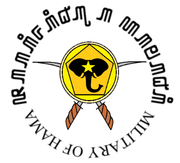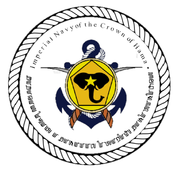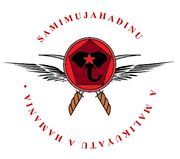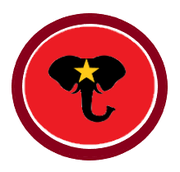Military of the Hamanian Empire
| This page is a work in progress by its author(s) and should not be considered final. |
| Military of the Hamanian Empire Jahidinu Hamani | |
|---|---|
 Emblem of the Hamanian Military | |
| Founded | 1870 - Armed Forces Act |
| Service branches |
|
| Headquarters | Komodu, Hama |
| Leadership | |
| Commander-in-Chief | King Maduallahu |
| Minister of Defence | Hussayinu Abadullahu |
| Manpower | |
| Military age | 17 |
| Conscription | Varies by territory |
| Active personnel | TBD |
| Reserve personnel | TBD |
| Expenditures | |
| Budget | ♅TBD |
| Percent of GDP | 2% |
The Hamanian Armed Forces (Hamanese: Jahidinu Hamani) form the military of the Hamanian Empire. The King of Hama is the commander-in-chief of the armed forces. The Minister of Defence is responsible for political direction and daily administration. The Chief of Staff is responsible for daily operations and management. The armed forces are made up of three branches: the Hamanian Army (which is responsible for terrestrial combat), the Hamanian Navy (which is responsible for maritime combat) and the Hamanian Air Force (which is responsible for aerial combat).
Contents
History
The concept of specialized units of men who were responsible for protecting an entity and projecting its power through force has always been around. The earliest organized units were from the merchant clans from one and a half years ago. These clans were great traders who wandered from Hama to Listonia, trading goods. As these expeditions grew larger and more complex, primitive bureaucracies were established and specialized roles were assigned to their members. Infantry and combat units were formed. Some of these did not only have a defensive role, but an offensive one as well.
They would fight against one another or pillage tribes for treasure. Many sessile tribes began establishing specialized units to combat these merchants. This is evident about one thousand two hundred years ago. This is the beginning of the type of organized combat we see today. Through wars and development, small settlements grew into cities and small states controlling sizeable portions of land. Control of this lands varied and often ebbed and flowed, exchanging from one party to the other in a consistent fashion over the next few centuries. About eight hundred years ago, the Manonites, led by Hama, were able to develop tactics and an appetite for resources that led to the unification of a sizeable portion of land that comprises over half of what makes up Hama today.
Many tribes retained these militaries, but a central authority in the King was able to limit and influence what those forces could do. The Kings would lead armies made up of different tribes to battle against invaders or to expand the territory of Hama or forcefully promote whatever strategic interests that the King had in mind. These armies were the first examples of joint and uniform military exercises. Gradually, the tribes adopted common combat norms and rank structures, to make cooperation more effective and easy.
About six hundred years ago, maritime navigation was still a commercial and fairly limited exercise. Then the first dhows were invented. The Hamanites copied this technology from the Packilvanians and developed this even further. Soon they were building their own boats and travelling longer distances than they had before. They were faced with pirates and foreign attacks, so their ships were equipped with fire power of their own. Eventually specialized combat ships, the first ones being deployed five hundred years ago. These were fairly simple and travelled fairly short distances.
As available tools, materials and techniques were enhanced and enlarged, they could build more ships. The king often sent parties to other parts of the "known world" , particularly Borea. These ships got bigger and more powerful. They were sent to find more trade routes and places to trade with. In this sense it was the Kings who first developed the concept of the navy. The king quickly seized this opportunity and was able to exercise a monopoly on maritime navigation and trade, so most of the naval power was held in central government hands.
About two centuries ago, the first aircraft became available. Their commercial applications and even scientific benefit was quickly apparent. The first concept of military applications emerged one hundred and fifty years ago. The state had a monopoly on this technology so they were the first and only body in the nation to explore these resources for military applications. The empire expanded and the role of naval and aerial forces grew much bigger. This need has not changed much, but the technology, skills and leadership have all adapted and augmented to handle this new world.
In 1870, the Armed Forces Act was passed to create a single legal framework for the armed forces of the land and wrest control of the military from the monarchy and put some parliamentary oversight over the body and a professional service in place. This law has undergone many revisions to handle the new world and the demands that that world places on Hama and its strategic interests.
The current era, that being the past fifty years to the present, the nature of combat has change significantly. About a century ago the first missiles were built in South Hills. It was only forty years later around the 1940s that Hama was able to build its own. This technology enhanced and the outer space applications were explored. While a sophisticated space combat system was not developed, space provided additional support to the military and catalyzed development of the internet. This technology has been worked on by many countries in the world.
Hama was new to this, but has developed and advanced exponentially in a short period of about twenty years. The digital world has provided the means to explore unconventional combat such as unmanned remote controlled mechanized aerial and terrestrial combat. This technology is still developing and may take another decade or two fully materialize. Even cyber combat has given a new dimension that did not exist and was not around before.
Army
The Hamanian Army forms the terrestrial component of the armed forces. This means that it handles operations on land. The army is a modern professional land force. It focuses on mechanised infantry and artillery. Its tactical doctrine is focused on conventional warfare. It is equipped to handle symmetrical combat with other armies. This doctrine arose from the threat of a Packilvanian invasion and the expansionism of Hama over the years.
Ranks
| Rank | Unit | Size |
|---|---|---|
| General | Field army | 2 - 4 × Corps |
| Lieutenant General | Corps | 2 × Division |
| Major General | Division | 2 × Brigade |
| Brigadier General | Brigade | 5 × Battalion |
| Colonel | Battalion | 5 × Company |
| Captain | Company | 5 × Platoon |
| Commander | Platoon | 5 × Squadron |
| Sergeant | Squadron | 2 × Team |
| Corporal | Team | 2 - 5 |
| Private | - | - |
Arsenal
The Army makes use of the following infantry equipment:
| Name | Origin | Type | Cartridge | Notes | Image |
|---|---|---|---|---|---|
| KP-2 | Kuthernburg | Semi automatic pistol | 9mm Spec 3 | Standard issue infantry handgun | |
| Ferrus SC-P11 | United Kingdom | Semi automatic pistol | 9mm x 19 | Special forces | 
|
| Ferrus SC-AR4 | United Kingdom | Assault rifle | 5.56x45mm | Standard issue infantry rifle | |
| BG-90 | Kuthernburg | Sniper rifle | 7.6 x 51mm | Special forces | 
|
| SB-92 | Kuthernburg | Sub-machine gun | 9mm | Special combat roles | |
| KN-14 | Kuthernburg | Machine gun | 7.62×51mm | Special combat roles | 
|
| Danal RBGL | United Kingdom | Grenade launcher | 40mm grenade | Special combat roles | |
| K2-LMS | Kuthernburg | Mortar | 81mm | Special combat roles | 
|
The Army makes use of the following vehicles:
| Name | Origin | Type | Number | Image |
|---|---|---|---|---|
| Main battle tank | 200 | [[File:|100px]] | ||
| Infantry fighting vehicle | 300 | [[File:|100px]] | ||
| Armored personnel carrier | 300 | [[File:|100px]] | ||
| Reconnaissance vehicle | 200 | [[File:|100px]] | ||
| Fire support | 150 | [[File:|100px]] | ||
| Medical evacuation | 250 | [[File:|100px]] |
They Army makes use of the following aircraft:
| Name | Origin | Type | Number | Image | Notes |
|---|
Uniforms
- Example.jpg
Dress Uniform
- Example.jpg
Desert Fatigues
- Example.jpg
Forest Fatigues
The Imperial Navy forms the maritime branch of the armed forces. It was founded in the 17th century CE and has remained in service to this day. It was reconstituted as the Imperial Navy when colonisation of Borea had advanced significantly. Prior to that point it was called the Royal Navy. The Royal Navy was formally founded 300 years prior, in the 14th century. It began as a small fleet of civilian ships and warships owned and managed by the King in his personal capacity, but the force was expanded as Hamanian maritime trade expanded. The Royal Navy was eventually consolidated into a public entity and a branch of the military in the 15th century. The Imperial Navy facilitated the expansion of the Hamanian Empire. It has a history of naval combat for instance the Battle of Vaarisvalla Bay against Kalatianburg in 1650 and the Battle of Lake Warre in 1730 against Laiatan and Warreland. This force focuses on defending Hamanian territory from naval attacks and asserting Hamanian territorial control. While it has expeditionary capabilities and ambitions, it remains primarily deployed in the Borean Sea and Gulf of Itur.
The Imperial Navy forms the second largest branch by number of personnel. It employs 40,000 combat and civilian personnel such as firefighters, medics, sailors, navigators and pilots. Sailors are trained and educated in the Imperial Naval Academy in Komodu for 3 years before being inducted to serve in the navy. The Imperial Navy is helmed by the High Commander who handles daily issues such as administration, deployment, discipline and strategy. The Imperial Navy has a diverse culture. Due to the long periods that sailors are deployed on one ship, each ship or naval deployment has a distinct culture of its own. In general, sailors, while rough, are disciplined and reliable.
The Imperial Navy has an arsenal of 60 commissioned ships including submarines. The Imperial Navy benefits from a technologically advanced and experienced domestic shipbuilding industry. The sector is largely dominated by the Royal Shipwrights Company which serves as the primary domestic supplier of the armed forces. Due to budgetary constraints, the Imperial Navy has struggled to make significant expansions to its arsenal, opting instead to update existing vessels on a regular basis. The Imperial Navy possesses 1 aircraft carrier, 2 amphibious assault vessels, 6 destroyers, 11 frigates, 10 corvettes, 10 diesel-powered submarines, 2 ballistic missile submarines, 2 replenishment ships, 1 icebreaker/research/search-and-rescue vessel, and 5 research/large patrol/search-and-rescue vessels, 3 mine countermeasures vessels, 4 fast off-site patrol boats and 3 transport and training ships leased from the Royal Trade Company.
Rank
| Rank | Size | Unit |
|---|---|---|
| Admiral | 2 × Task Forces | Fleet |
| Rear Admiral | 2 × Task Group | Task Force |
| Vice Admiral | 4 × Task Unit | Task Group |
| Commodore | 3 × Task Team | Task Unit |
| Commandant | 5 × Task Element | Task Team |
| Captain | 1 × ship | Task Element |
| Lieutenant | Part of ship | Task Detail |
| Private | - | - |
Arsenal
The Navy makes use of the following ships:
| Class | Origin | Type | Number | Image | Notes |
|---|
The Navy makes use of the following aircraft:
| Name | Origin | Type | Number | Image | Notes |
|---|
Uniforms
- Example.jpg
Dress Uniform
- Example.jpg
Naval Gear
- Example.jpg
Pilot Suit
Air Force
The Hamanian Air Force forms the aerial component of the armed forces. This means that it handles operations in the air. The air force is equipped with air superiority fighters. The air force has attempted to modernise its arsenal to have flexibility in its operations and increase its ability to combat asymmetric foes. It has electronic reconnaissance capabilities and unmanned combat capabilities. The latter is still undergoing significant modernisation and consolidation.
Ranks
| Rank | Size | Unit |
|---|---|---|
| General | 2 - 4 × Task Force | Command |
| Lieutenant General | 2 × Task Group | Task Force |
| Major General | 3 × Task Unit | Task Group |
| Brigadier General | 4 × Task Team | Task Unit |
| Colonel | 5 × Task Element | Task Team |
| Captain | 5 × Task Detail | Task Element |
| Lieutenant | 5 × Task Component | Task Detail |
| Sergeant | 2 - 5 × aircraft | Task Component |
| Private | 1 × aircraft | - |
Arsenal
The air force makes use of the following aircraft:
| Name | Origin | Type | Number | Image | Notes |
|---|
Uniforms
- Example.jpg
Dress Uniform
- Example.jpg
Pilot Suit
Manpower
All adult male citizens who are fit to serve are required to complete a year of military training and military service once a year. Volunteers complete an additional year of training to be inducted into the armed forces. An additional year of training is required to join the Navy and the Air Forces. Females are not permitted to serve in combat roles. The Hamanian Armed Forces has 200,000 active personnel. This forms 1% of the population.
Finances
The Hamanian Armed Forces have a budget of 20 billion dollars. This forms 5% of GDP and 10% of the annual budget. The budget has increased by 1% on average for the past few years. This is a fairly small adjustment by modern standards. This can be attributed to fiscal constraints. This increase is largely used to cover operational expenses in line with inflation.
Current deployment
The Hamanian Armed Forces are deployed in the colonies to protect Hamanian territorial claims. This means that the forces are responsible for protecting the colonies from foreign invasions and suppressing armed rebellion. The tendency of colonies to rebel has varied across different colonies. The more inclined the colony is to violence, the greater the presence and higher the mobilization of those forces within that territory will be.
Paramilitaries
Each colony has an indigenous paramilitary force that is run by the colonial government. This force is limited to land-based operations. It can only conduct operations on land. These forces typically work part-time. They are typically trained for a year. The Hamanian Army works closely with these forces. Standardised ranks and organisation have been adopted.







